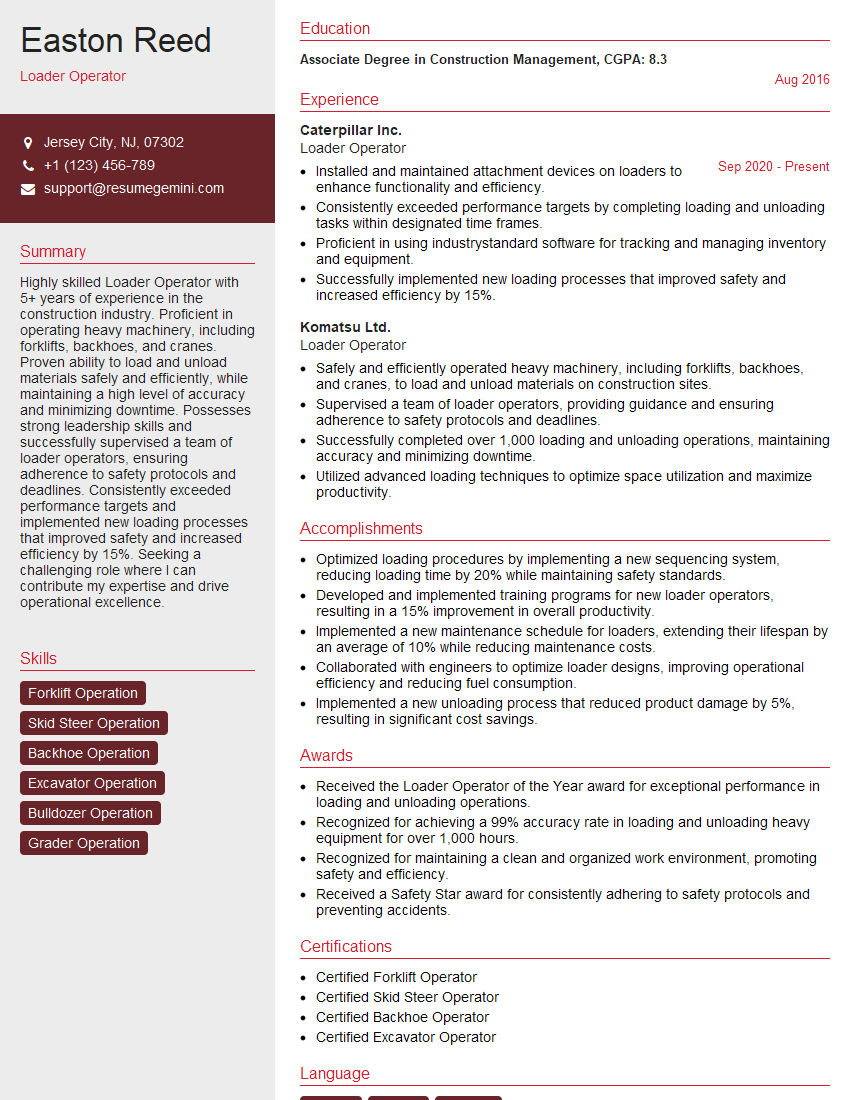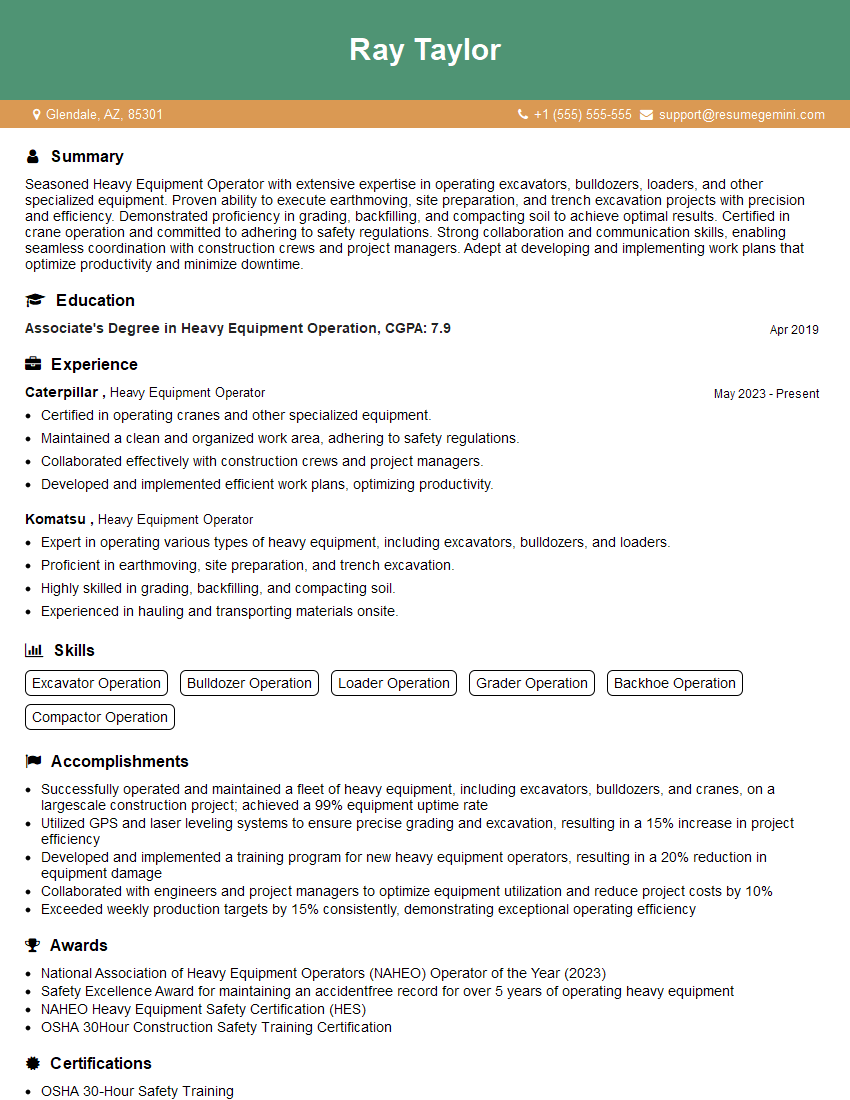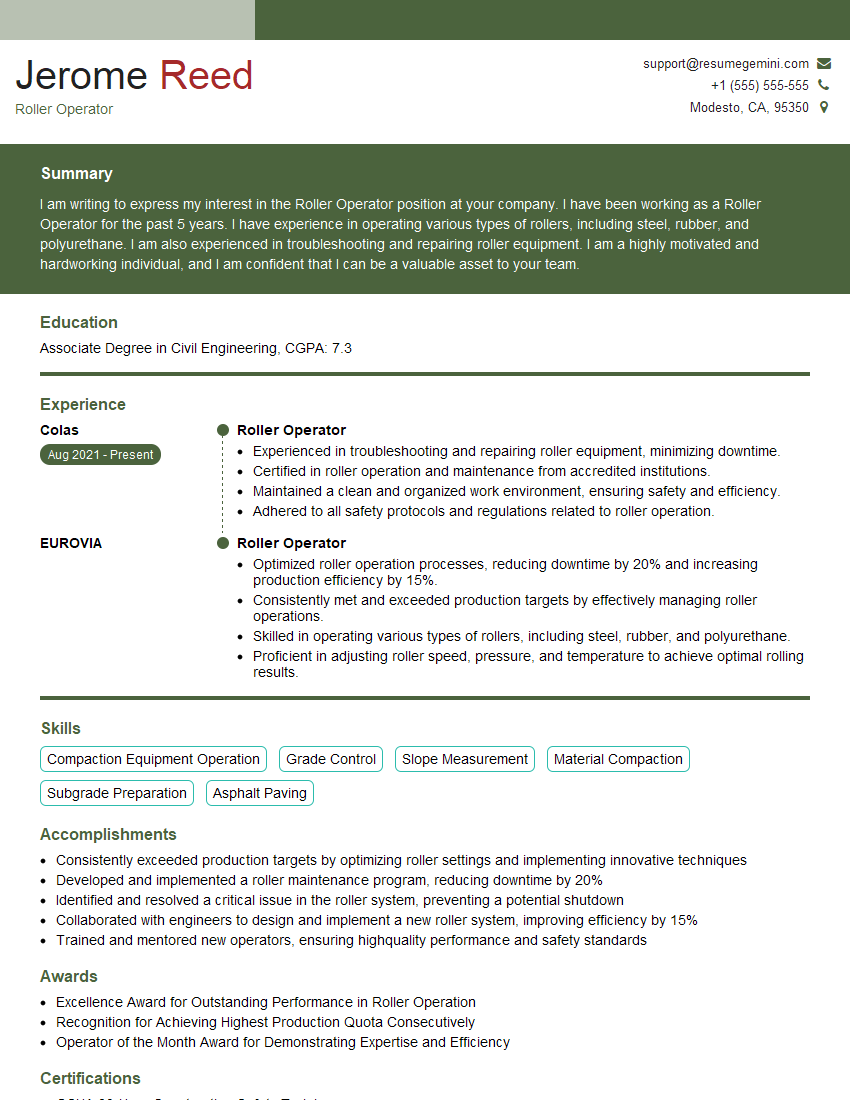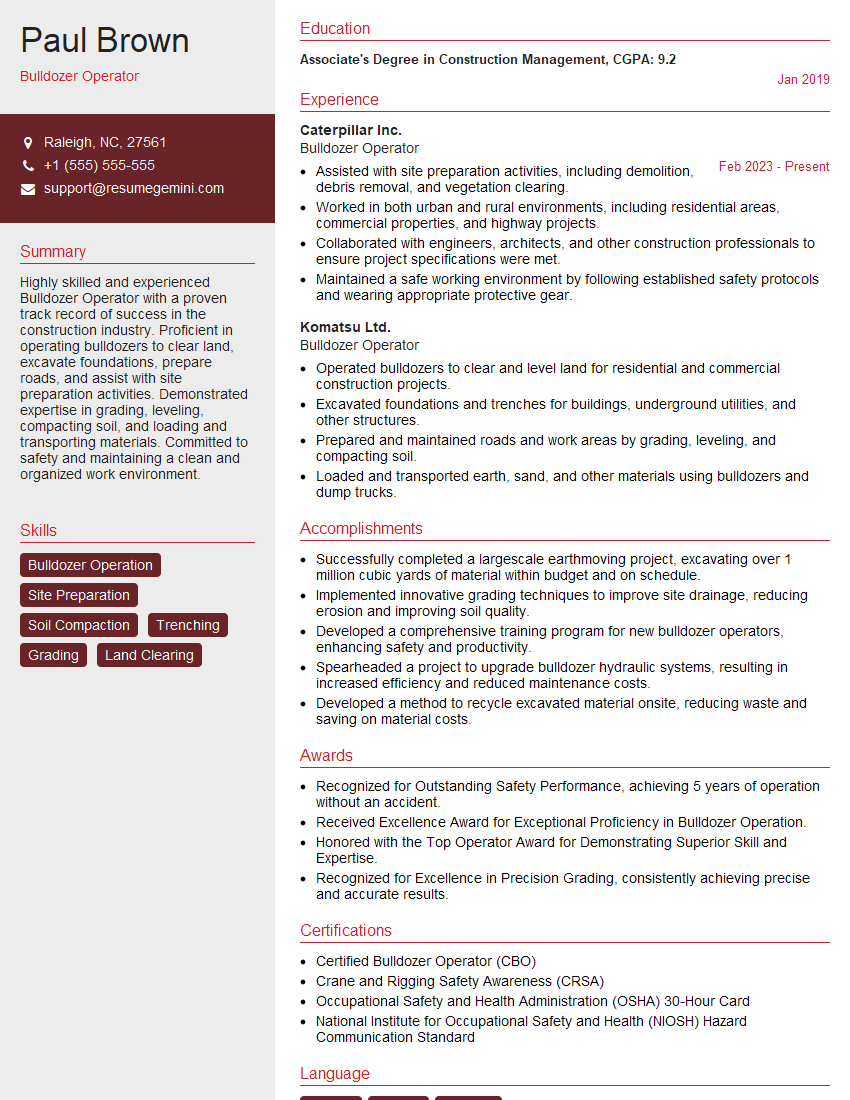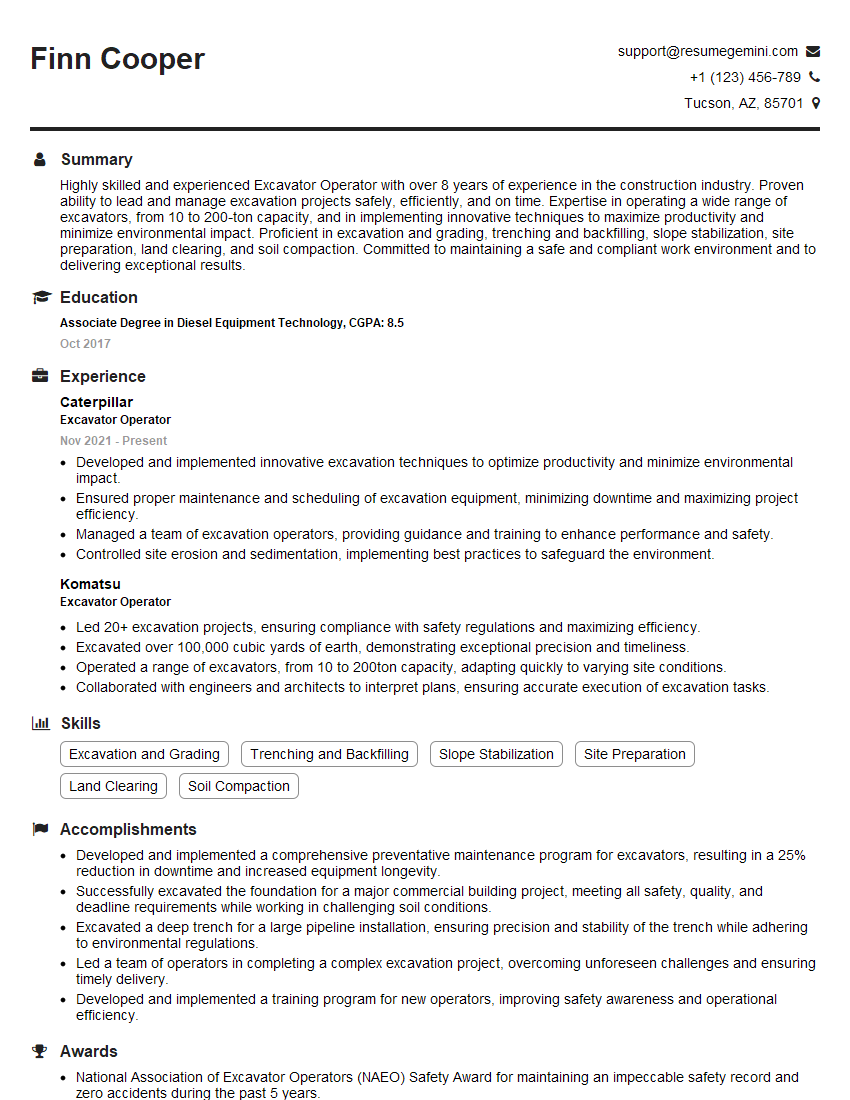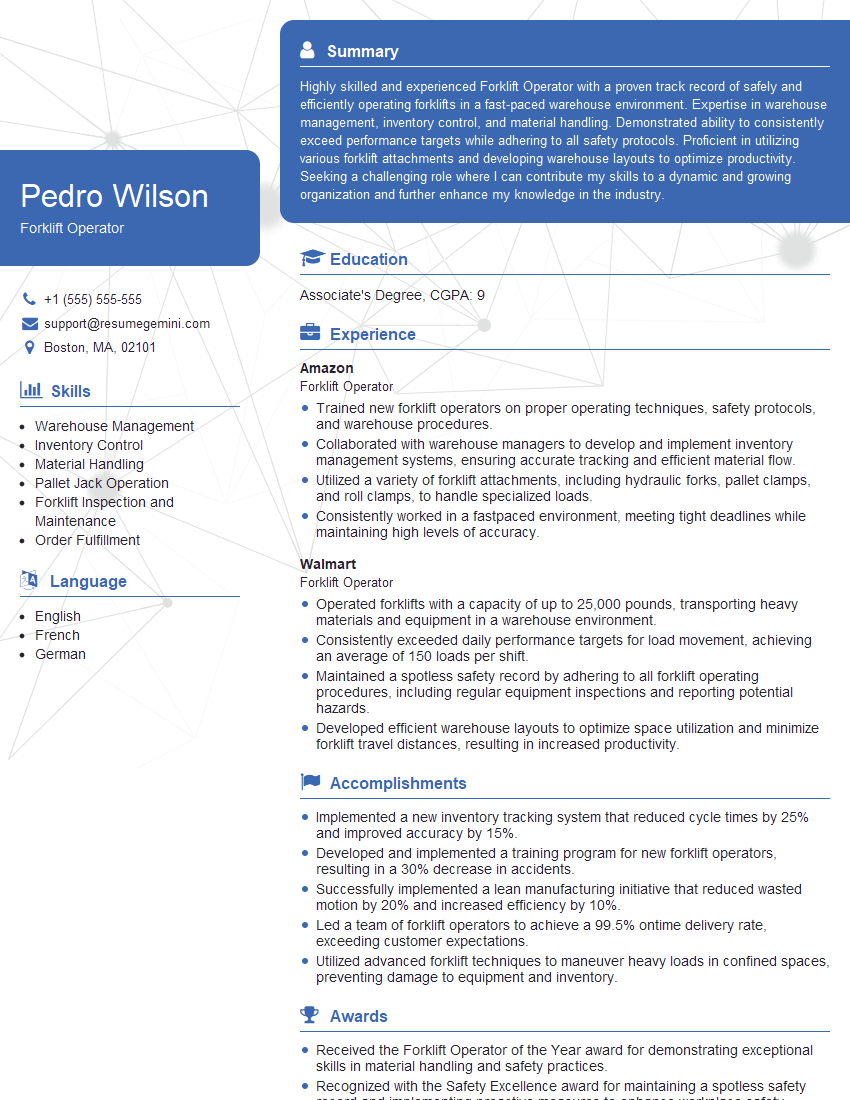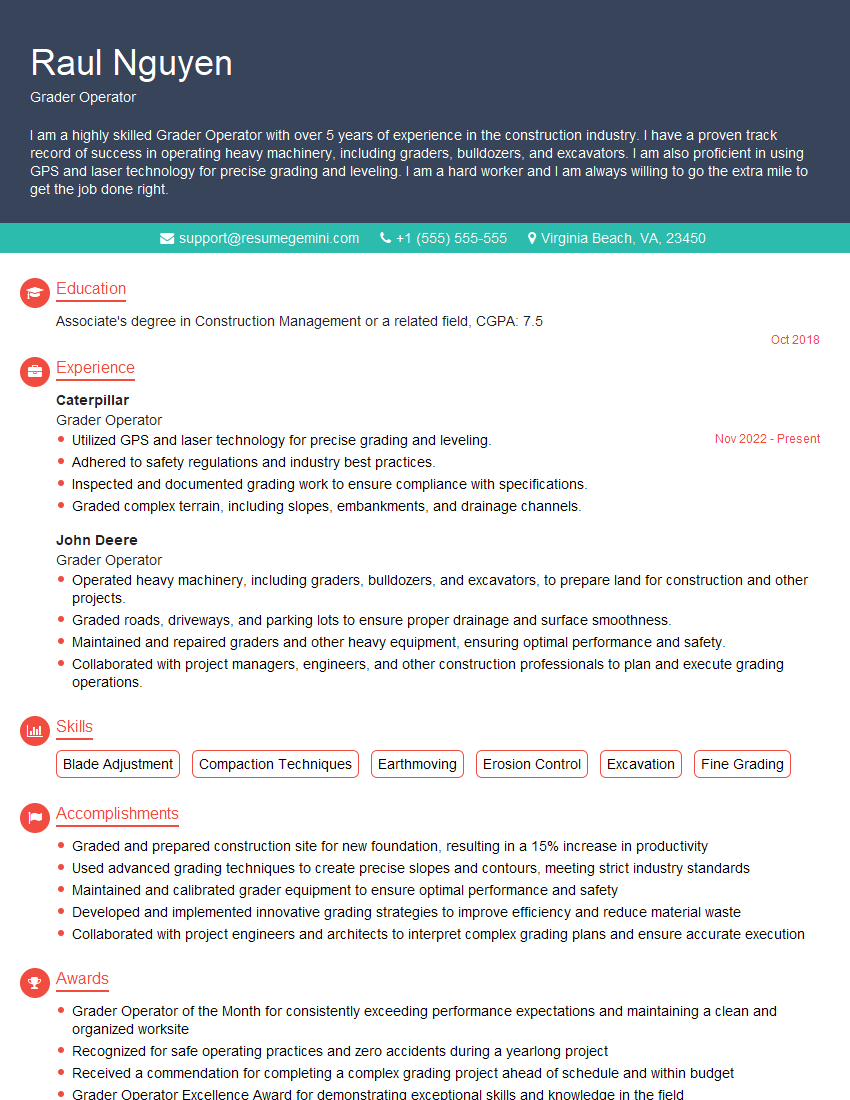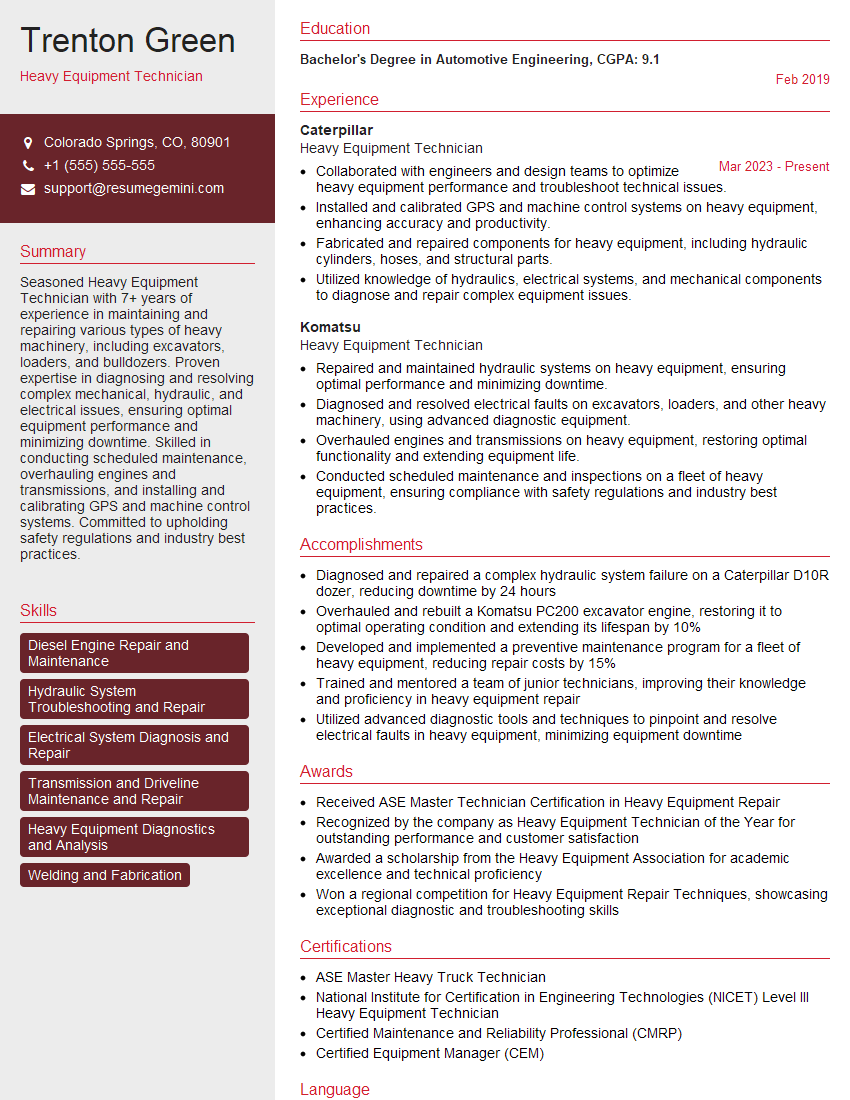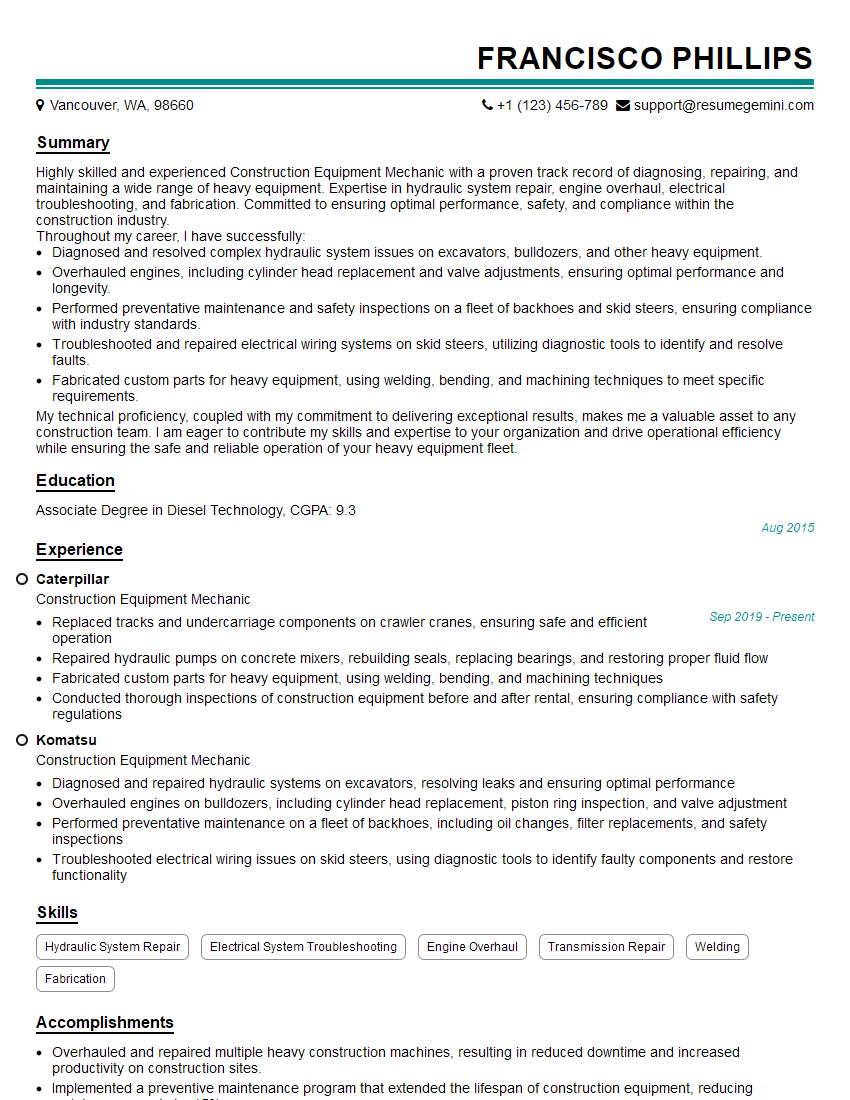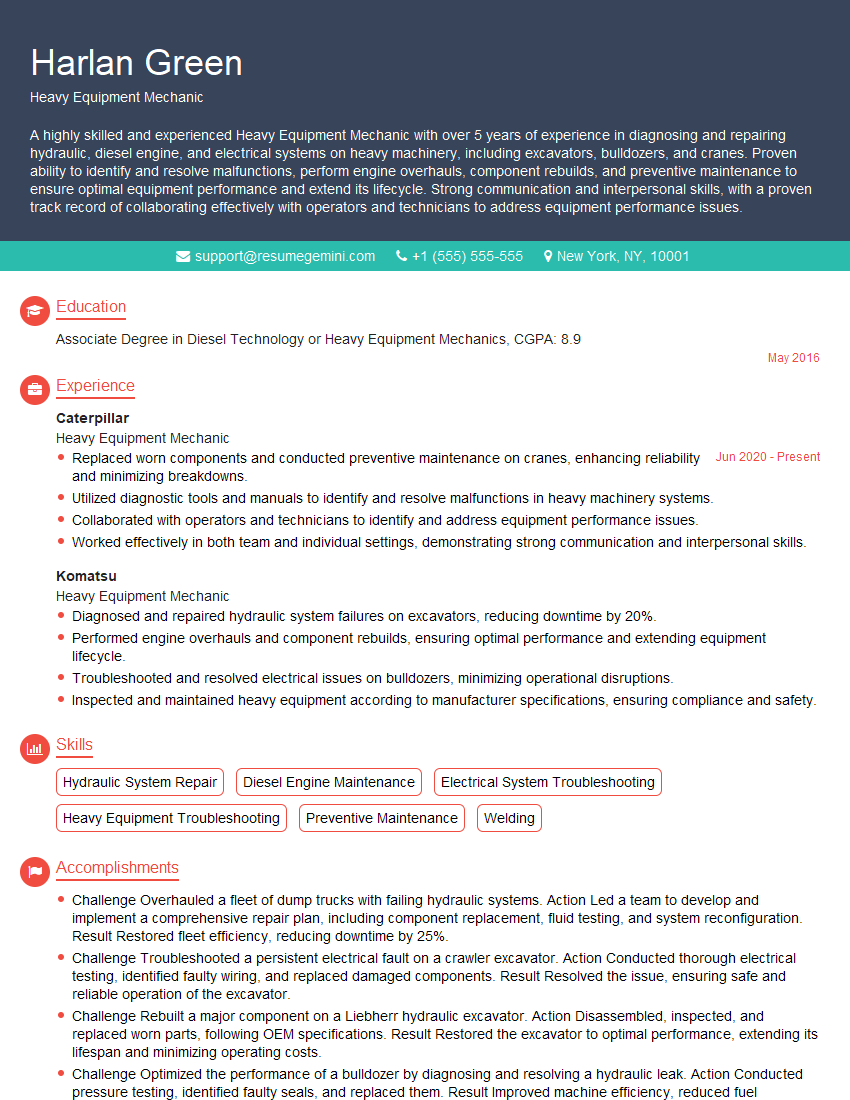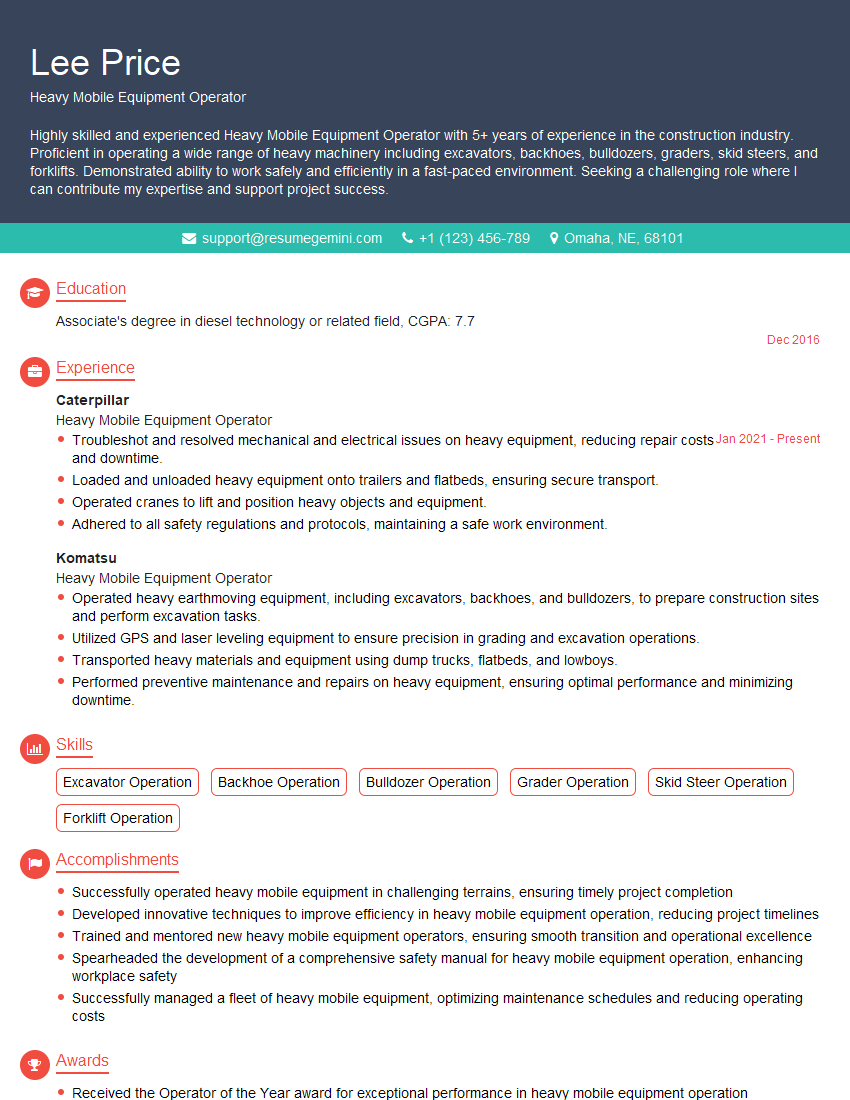Cracking a skill-specific interview, like one for Heavy Equipment Operation (if applicable), requires understanding the nuances of the role. In this blog, we present the questions you’re most likely to encounter, along with insights into how to answer them effectively. Let’s ensure you’re ready to make a strong impression.
Questions Asked in Heavy Equipment Operation (if applicable) Interview
Q 1. Describe your experience operating excavators.
My experience with excavators spans over eight years, encompassing various models and projects. I’ve operated everything from compact excavators for trenching and utility work to large-scale excavators used in mass earthmoving for highway construction and large-scale land development. I’m proficient in both conventional and hydraulic systems. For instance, on a recent highway project, I used a 30-ton excavator to excavate and load material for a large embankment, ensuring precise grading and minimizing material waste. Another project involved using a smaller excavator for delicate utility work near existing structures, requiring careful control and precision to avoid damage.
My skills extend beyond basic operation to include efficient digging techniques, material handling and loading, and effective utilization of excavator attachments like breakers and thumbs. I’m also experienced in working in confined spaces and challenging conditions. For example, I successfully managed to excavate a trench in a densely populated residential area, carefully maneuvering the machine to avoid damaging nearby structures.
Q 2. What safety procedures do you follow when operating heavy equipment?
Safety is paramount in heavy equipment operation. My safety procedures always begin with a thorough pre-operational inspection. This includes checking fluid levels, tire pressure, and overall machine condition. Before starting, I ensure the area is clear of personnel and obstructions. I always wear the appropriate personal protective equipment (PPE), including a hard hat, safety glasses, high-visibility vest, and hearing protection. While operating, I maintain a safe distance from any other equipment or personnel. I’m vigilant about blind spots, using mirrors and spotters when necessary. I never operate the equipment under the influence of drugs or alcohol. I always follow the manufacturer’s safety guidelines, site-specific safety rules, and my company’s safety policies.
Communication is key – I use hand signals, radios, and other designated communication methods to coordinate with other operators and ground personnel. I regularly conduct visual inspections of the work area to identify potential hazards and immediately report any unsafe conditions. Regular safety training is crucial, and I actively participate in these sessions to keep my knowledge up-to-date and react to potential hazards immediately.
Q 3. Explain the pre-operational checks you perform before operating a bulldozer.
Pre-operational checks for a bulldozer are critical for safe and efficient operation. I always start with a visual inspection, checking for any leaks, loose parts, or damage. I inspect the tracks for wear and tear, ensuring proper tension. I check fluid levels – engine oil, transmission oil, hydraulic fluid, and coolant – making sure they are within the acceptable range. I also verify that the blade is securely attached and properly adjusted. The lights, horn, and other signaling devices are checked for functionality. I test the steering and braking systems to ensure they respond correctly. Fuel levels are verified, and I check for any potential obstructions near the machine. A final walkaround helps to make certain nothing has been overlooked. This comprehensive inspection not only ensures the safe operation of the bulldozer but also prevents costly repairs and downtime. For instance, a small leak identified early can prevent major engine damage later.
Q 4. How do you handle challenging terrain while operating a grader?
Operating a grader on challenging terrain requires experience, skill, and careful planning. I assess the terrain before starting work, identifying potential hazards such as soft ground, rocks, or steep slopes. I adjust my speed and approach based on the conditions. For soft ground, I use a lower gear and a wider blade spread to distribute the weight evenly and prevent getting bogged down. On steep slopes, I work slowly and carefully, avoiding any sudden movements that might cause loss of control. I frequently utilize the grader’s rippers and other attachments, to loosen and break up hard or rocky sections. I frequently use my experience and knowledge of different grading techniques and techniques to adjust my approach to ensure successful and safe completion of my tasks.
I also understand the importance of maintaining stability and balance. Keeping the weight of the machine evenly distributed is essential for maneuvering across uneven ground. I utilize my knowledge of the machine’s center of gravity to make sure the machine operates within its capabilities. For example, when working on a slope, I would maintain a balanced posture and avoid any sudden changes in direction, which could result in an accident.
Q 5. What are the different types of loaders and their applications?
Loaders come in many types, each suited for specific tasks.
- Wheel loaders are highly versatile and commonly used for moving bulk materials like dirt, gravel, and snow. Their mobility makes them suitable for various terrains. I’ve used them extensively in construction sites for loading trucks and moving materials around.
- Backhoe loaders combine a front-end loader with a backhoe, offering flexibility for digging, loading, and lifting. They are useful in smaller-scale projects where maneuverability is crucial. I’ve used these for trenching and foundation work on smaller projects.
- Skid steer loaders are compact and highly maneuverable, ideal for confined spaces. They are widely utilized in landscaping and other projects where space is limited. I’ve employed these for precise grading and material handling in residential projects.
- Telescopic handlers, or telehandlers, offer extended reach for lifting and placing materials. I’ve used them for placing materials in hard-to-reach areas on larger construction sites.
Q 6. Describe your experience with preventative maintenance on heavy equipment.
Preventative maintenance is essential for maximizing the lifespan and efficiency of heavy equipment. My experience includes conducting daily pre-operational checks as previously described. Beyond this, I’m familiar with routine maintenance tasks like changing oil and filters, inspecting and lubricating components, checking and adjusting belts and hoses, and checking for any signs of wear and tear. I meticulously record all maintenance activities in logbooks, following the manufacturer’s recommended service schedules. I understand the importance of keeping the equipment clean and free of debris to prevent damage and improve efficiency. This routine maintenance has helped minimize downtime and costly repairs over the course of my career. I am also capable of carrying out minor repairs on-site such as changing hydraulic filters or fixing minor leaks, which significantly reduce downtime and keeps projects on track.
Q 7. How do you troubleshoot common mechanical issues on excavators?
Troubleshooting excavators involves a systematic approach. I start by identifying the problem – is the machine not starting, is there a hydraulic leak, or is there a problem with movement? Then, I will systematically analyze the situation. For example, if the excavator won’t start, I’ll check the battery, starter motor, and fuel system. If there’s a hydraulic leak, I’ll trace the source of the leak and identify the damaged component. For issues with movement, I would inspect the hydraulic system components, such as cylinders and pumps. I use diagnostic tools when needed, such as pressure gauges for hydraulic systems and multimeters for electrical systems. My experience has taught me to look for telltale signs that help to diagnose a mechanical problem. For example, unusual noises or vibrations can indicate a problem with bearings or other moving parts. My understanding of both hydraulics and electrical systems enables me to effectively resolve these situations. Safety precautions are always paramount, and I would always ensure the machine is switched off and secured before performing any repairs or diagnostics.
Q 8. Explain the importance of load capacity and stability.
Load capacity and stability are paramount in heavy equipment operation; they directly impact safety and efficiency. Load capacity refers to the maximum weight a machine can safely lift or carry. Exceeding this limit can lead to catastrophic equipment failure, injuries, or even fatalities. Stability, on the other hand, relates to the machine’s ability to remain upright and balanced under load. An unstable machine is prone to tipping, which again poses significant safety risks.
Think of it like this: Imagine trying to carry a stack of heavy books. Your load capacity is how many books you can physically lift without dropping them. Your stability is how well you maintain your balance while carrying them. If you try to carry too many (exceeding load capacity), or if your center of gravity is off (poor stability), you’ll likely fall. In heavy equipment, we use load charts and diagrams that specify the safe working load for different boom lengths and configurations to ensure both load capacity and stability are within safe limits.
For example, when operating a crane, we always consider the weight of the load, the boom angle, and the ground conditions to ensure both load capacity and stability are maintained. We never exceed the rated capacity and always carefully position the crane to prevent tipping.
Q 9. What are the different types of crane operations?
Crane operations are diverse, depending on the type of crane and the task at hand. Broadly, they can be categorized as follows:
- Overhead Crane Operations: These involve cranes mounted on overhead runways or gantry systems, typically used in factories or warehouses for moving materials. Operations include lifting, lowering, and traversing loads horizontally.
- Mobile Crane Operations: This covers a wide range of cranes, including crawler cranes, truck cranes, and all-terrain cranes, used on construction sites and in various industrial settings. These require careful consideration of site conditions, including ground stability and load placement.
- Tower Crane Operations: Tower cranes are tall, freestanding structures used primarily in high-rise construction. Their operation involves precise control and coordination to manage loads at significant heights.
- Floating Crane Operations: These cranes are mounted on barges or ships and operate on water bodies, handling heavy objects in maritime applications, such as bridge construction or offshore work.
Each type requires specialized training and expertise, with specific safety protocols and operating procedures.
Q 10. How do you ensure the safety of yourself and others while operating a crane?
Safety is paramount in crane operation. It’s a fundamental principle, not an afterthought. My safety procedures include:
- Pre-Operational Checks: A thorough inspection of the crane’s mechanical and electrical components, including brakes, hydraulics, and load-indicating devices, is always my first step. I always check the crane’s stability and ensure that its base is level and secure. No short-cuts allowed.
- Proper Signaling and Communication: Clear communication with the signal person is crucial. We use standardized hand signals or two-way radios to ensure everyone understands the planned movement of the load. I’ll also have visual confirmation of the load’s surroundings and pathways.
- Safe Load Handling: I meticulously check load weights, centers of gravity, and sling configurations to prevent load instability. I avoid swinging loads near personnel or obstacles.
- Awareness of Surroundings: I constantly scan my surroundings for potential hazards, including overhead obstructions, ground conditions, and the presence of personnel. I establish a safe radius around the crane to protect others.
- Compliance with Regulations: I adhere to all relevant safety regulations, including those set by OSHA and other governing bodies. Following company safety protocols is critical.
Remember, safety isn’t just about following rules; it’s about anticipating problems and proactively preventing them. I make continuous risk assessment an integral part of every job.
Q 11. Describe your experience working with GPS or machine control systems.
I have extensive experience with GPS and machine control systems, primarily using them for precision earthmoving and grading. In my previous role, we used GPS-guided bulldozers and excavators to achieve extremely accurate grading on a large highway project. The system overlaid a digital terrain model onto the real-world site, guiding the machine’s movements to meet precise design specifications.
These systems significantly improved efficiency and accuracy. For example, using GPS-guided machines, we could consistently achieve grade tolerances within a few millimeters, whereas traditional methods would have had a much wider margin of error. This reduced the need for rework, saving both time and materials.
My experience also includes working with machine control systems that integrate with 3D modeling software. This allows us to see the planned design model in real-time on a display in the cab, providing visual confirmation of our progress and ensuring we stay on track.
Q 12. How do you interpret blueprints and site plans for equipment operation?
Interpreting blueprints and site plans is a critical skill. I start by familiarizing myself with the overall project layout, identifying key landmarks and areas of operation. Then I focus on details relevant to my equipment: I study dimensions, elevation profiles, and the locations of utilities, obstructions, and other potential hazards.
For example, when working on a pipeline project, I’ll carefully review the alignment sheets to understand the pipeline route, depth, and any required horizontal or vertical curves. I would also look for details on any underground utilities to prevent damage during excavation. I’ll note any special considerations, such as soil type or potential for ground instability, to ensure I operate my equipment safely and efficiently.
I often use site plans in conjunction with GPS or machine control systems. This integrated approach ensures precise operation and minimizes deviations from the planned design.
Q 13. What are your strategies for working efficiently and productively?
My strategies for efficient and productive work revolve around careful planning and execution. I begin by thoroughly understanding the task at hand, including the scope of work, required materials, and deadlines.
- Efficient Sequencing: I prioritize tasks and sequence them logically to minimize downtime and maximize productivity. This might involve strategically positioning equipment to minimize travel time or organizing materials for easy access.
- Effective Tool Usage: I select the appropriate tools and attachments for the job, ensuring they are properly maintained and in good working order. A well-maintained machine is a productive machine.
- Preventive Maintenance: Regular maintenance of my equipment ensures optimal performance and prevents unexpected breakdowns. This involves performing routine checks and addressing any issues promptly.
- Teamwork and Communication: Effective communication and collaboration with other team members contribute to a smooth workflow and avoid delays.
Ultimately, efficiency is about optimizing the entire process, from planning to execution. I constantly seek ways to improve workflows and eliminate bottlenecks.
Q 14. How do you manage fuel consumption and optimize equipment performance?
Managing fuel consumption and optimizing equipment performance are intertwined. My approach focuses on several key areas:
- Proper Operation: Operating the equipment according to the manufacturer’s recommendations, avoiding unnecessary idling, and using appropriate techniques (e.g., smooth acceleration and deceleration) greatly impacts fuel efficiency.
- Preventive Maintenance: Regular maintenance, including air filter changes, engine tune-ups, and lubrication, ensures the engine is running efficiently and consuming less fuel. A well-maintained machine always operates better.
- Load Management: Matching the equipment’s capacity to the task at hand. Overloading the engine leads to increased fuel consumption and potential damage.
- Fuel Type and Quality: Using the correct grade of fuel as specified by the manufacturer and ensuring its quality helps prevent engine problems and poor fuel economy.
- Operator Skill: Experienced operators develop techniques that minimize fuel consumption while maintaining productivity. Smooth and controlled operations are key.
By focusing on these areas, I can significantly reduce fuel consumption and extend the lifespan of the equipment, ultimately contributing to lower operating costs and environmental responsibility.
Q 15. Describe your experience with different types of soil and ground conditions.
My experience encompasses a wide range of soil and ground conditions, from loose sandy soils to dense clay, rocky terrain, and even swampy areas. Understanding soil type is critical for safe and efficient operation. For example, operating a bulldozer on loose sand requires a different approach than working on hard-packed clay. Loose sand necessitates slower speeds and careful maneuvering to avoid sinking or causing instability. Conversely, dense clay might require specialized ripper attachments to break it up, and rocky terrain calls for more cautious operation to avoid damaging the equipment’s undercarriage.
- Sandy Soils: Require careful speed control to avoid getting bogged down. I often adjust the blade angle to minimize penetration and prevent excessive slippage.
- Clay Soils: Can be extremely difficult to excavate. I’ve utilized different bucket types and techniques, including pre-wetting the soil in extremely dry conditions or utilizing a ripper to break up compacted areas.
- Rocky Terrain: Demands cautious operation, constant monitoring of the ground conditions, and careful selection of the equipment used to avoid potential damage.
- Swampy Areas: Necessitate the use of specialized equipment like amphibious excavators or the use of mats to distribute the weight and prevent sinking.
Career Expert Tips:
- Ace those interviews! Prepare effectively by reviewing the Top 50 Most Common Interview Questions on ResumeGemini.
- Navigate your job search with confidence! Explore a wide range of Career Tips on ResumeGemini. Learn about common challenges and recommendations to overcome them.
- Craft the perfect resume! Master the Art of Resume Writing with ResumeGemini’s guide. Showcase your unique qualifications and achievements effectively.
- Don’t miss out on holiday savings! Build your dream resume with ResumeGemini’s ATS optimized templates.
Q 16. What is your experience with operating equipment in confined spaces?
Operating heavy equipment in confined spaces requires a high level of skill, precision, and awareness. It’s not just about maneuvering the machine; it’s about understanding the limitations of the space, the potential hazards, and the safety precautions needed. For instance, working in a tight urban setting requires precise control to avoid collisions with buildings, power lines, or other obstacles. I’ve had experience working in construction sites with narrow access points and limited maneuvering room, needing to carefully plan each move to minimize the risk of accidents.
- Risk Assessment: Before starting any work in a confined space, I thoroughly assess the area for potential hazards. This includes identifying obstacles, utilities, and potential pinch points.
- Communication: Effective communication with spotters or other personnel is crucial to ensure safety and efficiency. Clear hand signals and radio communication are essential.
- Precise Maneuvering: Using small, controlled movements is critical. This avoids sudden actions that could lead to collisions or damage.
Q 17. How do you handle unexpected equipment malfunctions?
My approach to unexpected equipment malfunctions is systematic and safety-focused. The first step is always to ensure the safety of myself and others in the vicinity. I’ll shut down the equipment, secure the area, and then assess the situation. Depending on the severity of the malfunction, I’ll either attempt minor repairs if I’m qualified and it’s safe, or I’ll immediately contact my supervisor and maintenance personnel.
- Safety First: Always prioritize safety. If the malfunction poses a safety risk, shut down the equipment immediately and evacuate the area.
- Assessment: Determine the nature of the problem. Is it a simple hydraulic leak, an electrical issue, or something more serious?
- Reporting: Report the malfunction to the appropriate personnel, providing detailed information about the issue and the circumstances under which it occurred.
- Preventative Measures: Learning from the malfunction and suggesting preventative measures to avoid future occurrences is a crucial aspect of my job.
For example, if an excavator’s hydraulic system started leaking, I would shut down the machine, place warning cones around the area, and immediately notify my supervisor. I wouldn’t attempt a repair myself unless it’s a minor issue that I’m qualified to handle and poses no safety risk.
Q 18. How do you maintain accurate records of equipment operation and maintenance?
Maintaining accurate records is crucial for efficient operation and maintenance. I typically utilize both digital and physical methods. Digital records, usually maintained through software on a tablet or computer, are essential for tracking machine hours, fuel consumption, maintenance schedules, and any repair work performed. Physical logs, kept in a designated logbook or notebook, often serve as a backup and provide a quick reference point.
- Digital Records: I use specialized equipment management software to log operational hours, fuel usage, maintenance schedules, and parts replaced. This data is easily accessible and can be analyzed to track machine performance and predict potential issues.
- Physical Logs: I keep a physical logbook to record daily operational details, including weather conditions, soil types encountered, and any unusual events or observations.
- Pre- and Post-Operational Checks: I consistently perform pre- and post-operational checks and record these in both my digital and physical records, ensuring a detailed overview of the equipment’s status.
Q 19. Describe a time you had to adapt to a challenging work situation.
During a large-scale construction project, we experienced unexpected heavy rainfall that significantly softened the ground. This made operating the heavy equipment extremely challenging and risky. The initial plan had to be scrapped and a new strategy needed to be developed rapidly. We had to decide between halting operations altogether or adapting our work methods to ensure the safety of the crew and the equipment.
We opted for the latter, implementing a modified approach to the operation that focused on minimizing ground pressure. This included adjusting the ground pressure of the equipment, using wider tracks, and utilizing specific operating techniques to minimize ground disturbance. We successfully completed the project without any major incidents by effectively collaborating and adapting to the unexpected circumstances.
Q 20. How do you prioritize tasks and manage your time effectively on a job site?
Prioritizing tasks and managing time on a job site involves a combination of planning, communication, and efficient execution. My approach involves understanding the overall project goals, breaking down the tasks into smaller, manageable units, and then prioritizing those based on urgency and dependency. For example, tasks critical for the next phase of the project get precedence. I often utilize task management tools to visualize the workflow and ensure efficient completion.
- Project Planning: Understanding the project goals and the sequence of tasks is the first step in effective time management.
- Task Prioritization: I use tools and methods like Eisenhower Matrix (urgent/important) to prioritize tasks based on their impact and urgency.
- Communication: Regular communication with supervisors and fellow workers helps in coordinating tasks and adapting to unforeseen circumstances.
- Flexibility: Being flexible and adapting to unexpected delays or changes is crucial for effective time management on a job site.
Q 21. What are the legal and regulatory requirements for operating heavy equipment in your region?
(Note: This answer will vary depending on the region. Replace the following with the specific regulations of your area.) In my region, operating heavy equipment requires a valid operator’s license, which involves passing both a written and practical examination demonstrating competency and knowledge of safe operating procedures. Regular inspections of the equipment are mandatory, and all operators must adhere to stringent safety regulations, including wearing appropriate personal protective equipment (PPE) such as hard hats, safety glasses, and high-visibility clothing. Furthermore, there are specific regulations regarding working hours, operating near power lines, and safe working practices around other workers and the general public.
- Operator’s License: A valid license is required to legally operate heavy equipment.
- Regular Inspections: Equipment must undergo regular inspections to ensure safety and compliance.
- Safety Regulations: Strict adherence to safety regulations, including the use of PPE, is mandatory.
- Working Hours and Practices: Regulations dictate safe working hours and practices, focusing on worker safety and public safety.
Q 22. What safety certifications do you hold?
My safety certifications are comprehensive and reflect my commitment to safe operation of heavy equipment. I hold a valid Commercial Driver’s License (CDL) with HAZMAT endorsement, which is crucial for transporting materials on many job sites. I also possess OSHA 10 certification, demonstrating my understanding of workplace safety regulations. Furthermore, I’ve completed specialized training and hold certifications in operating specific machinery such as excavators, loaders, and bulldozers, with each certification specifying the exact machine model and safety protocols. These certifications are regularly updated to reflect the latest safety standards and best practices within the industry. For example, my excavator certification includes specific training on preventing tip-overs and working safely near trenches.
Q 23. What software or technology are you familiar with in relation to heavy equipment?
In today’s construction environment, technology plays a significant role. I am proficient in using GPS-guided machinery, which improves accuracy and efficiency, especially on large projects. This includes utilizing systems that provide real-time positioning data, preventing errors and optimizing fuel consumption. I’m also familiar with various machine monitoring systems, such as telematics software, which allows for remote diagnostics, predictive maintenance scheduling and tracking machine performance parameters like engine hours and fuel usage. This proactive approach minimizes downtime and reduces maintenance costs. Furthermore, I have experience with software used for creating digital terrain models (DTM) and designing earthmoving operations. This enhances planning precision and significantly reduces the chances of costly mistakes during the project execution.
Q 24. Describe your experience with different attachment types for loaders or excavators.
My experience encompasses a wide range of attachments for both loaders and excavators. With loaders, I’m adept at using buckets (various sizes for different material types), pallet forks for efficient material handling, and grapple attachments for moving logs or scrap metal. I’ve also used specialized attachments like snow removal blades and augers for specific tasks. On excavators, I’m familiar with a variety of buckets – from narrow trenching buckets to wide, general-purpose buckets. I have extensive experience using hydraulic breakers for demolition work and rippers for breaking up hard ground, as well as specialized digging buckets for different soil conditions. For example, I once used a specialized rock bucket on an excavator to efficiently remove large boulders during a site preparation project. Selecting the right attachment significantly improves efficiency and safety on every job.
Q 25. How do you communicate effectively with other team members on the job site?
Effective communication is paramount on a construction site. I prioritize clear and concise communication, using both verbal and non-verbal cues. Before starting any task, I always confirm the plan with my supervisor and team members, ensuring everyone is on the same page. I utilize hand signals for immediate communication, particularly in noisy environments, adhering to standardized industry hand signals to avoid misunderstandings. For more complex tasks, I use two-way radios for clearer communication over longer distances. If issues arise, I immediately report them using established channels to ensure prompt resolution. For instance, if I encounter an unexpected obstacle, I’ll use the radio to inform the foreman and propose a solution before proceeding. Active listening and respecting the opinions of others are crucial aspects of my communication style.
Q 26. Describe your problem-solving skills in relation to equipment maintenance.
My approach to equipment maintenance problem-solving is systematic and proactive. I begin by accurately identifying the problem through observation and diagnostic checks. This might involve checking fluid levels, inspecting for leaks, or listening for unusual noises. Once the problem is identified, I’ll consult the equipment’s manual and utilize my knowledge of the machine’s systems to determine the most effective solution. If the issue is minor, I’ll attempt a repair using my own expertise, always prioritizing safety. If the repair requires specialized tools or expertise, I’ll promptly report it to the supervisor. For example, I once diagnosed a hydraulic leak in an excavator by systematically checking each hydraulic line and identified a damaged hose. I then safely replaced the hose, preventing further damage and downtime. I meticulously document all maintenance activities for future reference.
Q 27. What is your approach to continuous learning and skill development in this field?
Continuous learning is vital in this rapidly evolving field. I actively seek opportunities for professional development, including attending workshops and seminars on new technologies and safety procedures. I regularly review technical manuals and online resources to stay updated on industry best practices. I also actively participate in online forums and communities to exchange knowledge and learn from experienced operators. I find that hands-on experience is invaluable, and I constantly seek opportunities to work with different types of equipment and attachments to broaden my skillset. My commitment to continuous learning ensures I remain at the forefront of the industry and consistently deliver high-quality work.
Q 28. What are your salary expectations?
My salary expectations are commensurate with my experience, qualifications, and the prevailing market rates for heavy equipment operators with my skillset and certifications. I am open to discussing a competitive compensation package that reflects my value to the company.
Key Topics to Learn for Heavy Equipment Operation Interview
- Equipment Specifics: Understanding the mechanics, operation, and limitations of various heavy equipment types (e.g., excavators, bulldozers, loaders, cranes). This includes knowing the differences in their applications and optimal use cases.
- Safety Procedures: Demonstrating a thorough understanding of all relevant safety regulations, pre-operational checks, and emergency procedures. This is crucial for showcasing your commitment to workplace safety.
- Maintenance and Troubleshooting: Familiarity with routine maintenance tasks, recognizing potential mechanical issues, and describing effective troubleshooting strategies. Employers value candidates who can proactively identify and address problems.
- Site Awareness and Planning: Explaining your approach to site assessment, planning efficient work routes, and understanding potential hazards in the work environment. This highlights your ability to work effectively and safely in diverse conditions.
- GPS and Technology Integration: Demonstrating familiarity with GPS systems, surveying techniques, and other technologies used in modern heavy equipment operation. This showcases your adaptability to modern industry standards.
- Legal Compliance and Regulations: Understanding relevant environmental regulations and permits, as well as legal responsibilities related to operating heavy equipment. This demonstrates responsibility and a commitment to adhering to rules and regulations.
- Teamwork and Communication: Highlighting your experience collaborating effectively with other crew members and supervisors, ensuring clear communication and coordination on-site. This emphasizes your ability to function as part of a team.
Next Steps
Mastering heavy equipment operation opens doors to a rewarding and well-compensated career, offering opportunities for advancement and specialization. To significantly boost your job prospects, it’s vital to create a professional, ATS-friendly resume that highlights your skills and experience effectively. ResumeGemini is a trusted resource to help you build a powerful resume that catches the eye of recruiters. They provide examples of resumes tailored to heavy equipment operation, allowing you to craft a document that truly showcases your expertise and readiness for success. Take the next step towards your dream career – create your winning resume today.
Explore more articles
Users Rating of Our Blogs
Share Your Experience
We value your feedback! Please rate our content and share your thoughts (optional).
What Readers Say About Our Blog
Hi, I have something for you and recorded a quick Loom video to show the kind of value I can bring to you.
Even if we don’t work together, I’m confident you’ll take away something valuable and learn a few new ideas.
Here’s the link: https://bit.ly/loom-video-daniel
Would love your thoughts after watching!
– Daniel
This was kind of a unique content I found around the specialized skills. Very helpful questions and good detailed answers.
Very Helpful blog, thank you Interviewgemini team.

